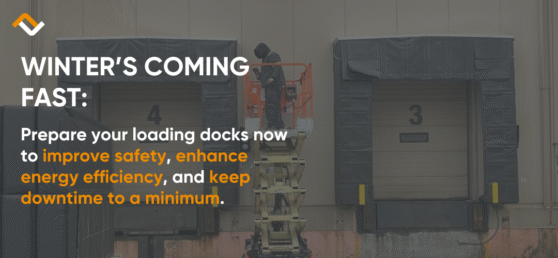
News
Winter’s Coming Fast: Prepare Your Loading Docks Now

Winter can bring a number of safety concerns to your operations, particularly at loading docks and bay doors. Ice and snow accumulation create hazards for personnel and increase the risk of equipment skidding or losing traction. Frost-covered or wet dock plates can cause both pedestrian and mechanical mishaps. However, winterizing your docks and doors can help you maintain peak operations in winter weather conditions.
Protecting Your Workforce: Safety Hazards During Winter
Fluctuating temperatures can lead to condensation and visibility issues, making it difficult for operators to execute tasks safely. Proper winterization—including weather seals, heated dock levelers, and anti-slip surfaces—directly addresses these risks, reducing the likelihood of accidents and ensuring compliance with safety standards.
Slashing Costs: How Winterization Boosts Energy Efficiency
Unsealed or poorly insulated loading docks and bay doors are significant sources of heat loss in warehouse and distribution environments. This thermal inefficiency forces HVAC systems to work harder, driving up energy consumption and operational costs during cold months. Winterization solutions such as dock shelters, insulated doors, and air curtains create barriers that minimize heat escape and block cold air infiltration.
By investing in winter prep, facilities can achieve reductions in energy-related costs.
Seamless Operations: Enhancing Productivity in Cold Conditions
Cold weather should not keep your facility from running smoothly. However, without proper winterization, loading docks and bay doors can become bottlenecks due to frozen mechanisms, ice accumulation, or slow-moving equipment. Delays not only impact workflow efficiency but can also compromise time-sensitive shipments and customer satisfaction.
Implementing winterization measures ensures that dock and door equipment—such as dock levelers, pallet trucks, and forklifts—remain functional and reliable. This proactive approach helps maintain high throughput even in adverse weather, allowing teams to focus on productivity rather than troubleshooting weather-related disruptions.
Solutions and Best Practices for Dock and Door Winterization
Installing heavy-duty weather seals, insulated overhead doors, and dock shelters are foundational steps. And regular inspections for seal integrity, mechanical performance, and moisture control prevent small issues from escalating during peak winter months.
Best practices also include training staff in winter safety protocols and establishing clear snow and ice removal routines around loading areas. Partnering with a full-service material handling provider ensures access to expert guidance, parts, and responsive service for maintaining dock and door performance year-round.
Long-term Benefits: Keep Your Operations Moving
Beyond immediate operational gains, winterizing loading docks and bay doors safeguards your team and products. Exposure to moisture and freezing temperatures accelerates wear on mechanical components, door tracks, and dock levelers, leading to increased maintenance costs and potential downtime.
Well-maintained, winter-ready docks and doors contribute to higher equipment uptime and a safer facility for your team. Contact us today to get your docks and doors winter ready.